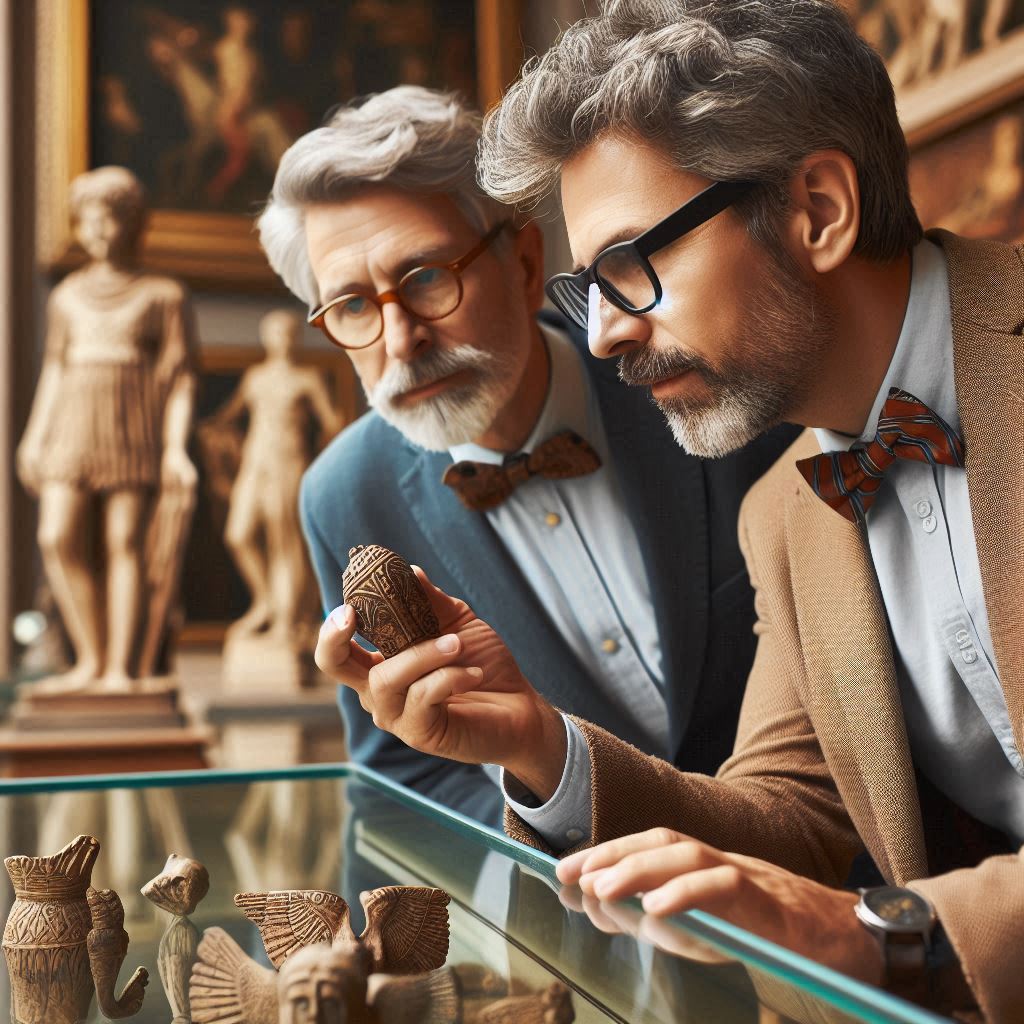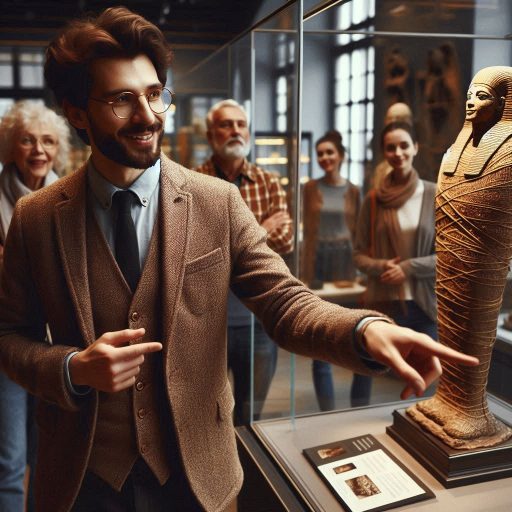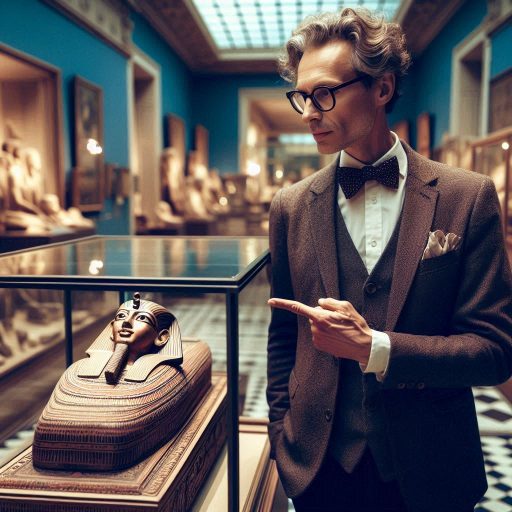Introduction
A museum curator plays a vital role in managing art collections and exhibitions.
Curators conduct research to deepen their understanding of artworks.
They also acquire new pieces to enhance the museum’s offerings.
Curators design exhibitions that engage visitors and tell compelling stories.
However, their responsibilities extend beyond the art itself.
They must also navigate administrative tasks that ensure the museum’s success.
This includes managing budgets, overseeing staff, and securing funding.
Curators work closely with artists, collectors, and the public to foster relationships.
They also engage in marketing strategies to promote exhibitions and events.
Balancing art and administration is crucial for a curator.
They must preserve artistic integrity while meeting operational goals.
This dual focus allows curators to create meaningful experiences for visitors.
Effective curators leverage their artistic vision alongside administrative acumen.
This balance drives a museum’s mission and enhances its impact on the community.
A successful curator cultivates an environment where art thrives within a well-organized framework.
The synergy between creativity and management defines their role in the museum world.
Overview of the Role of a Museum Curator
Museum curators play a vital role in the art world.
They balance creativity with administrative tasks.
Curators shape how audiences experience art and culture.
Their work involves meticulous planning and a deep understanding of art history.
A curator‘s impact extends far beyond the museum walls.
They foster connections between the public and the collections.
Responsibilities of a Museum Curator
Curators manage art collections with great care.
They acquire new pieces and ensure proper documentation.
Each artwork must be cataloged accurately.
This process includes research and record-keeping.
Curators also assess the condition of artworks regularly.
They work with conservators to preserve the pieces.
Exhibition planning is another key responsibility.
Curators develop themes and concepts for exhibitions.
They select artworks that align with these themes.
This involves careful consideration of the audience’s interests.
Curators create narratives that enhance the viewer’s experience.
They often collaborate with artists, collectors, and institutions.
Public engagement is essential for a curator.
They organize educational programs and community events.
These initiatives help demystify art for the public.
Curators also conduct tours and lectures.
They share insights about the artworks and their significance.
Effective communication skills are crucial in this aspect.
Curators must connect with diverse audiences and foster appreciation for art.
Importance of a Curator’s Role
Curators preserve cultural heritage through their work.
They safeguard artworks for future generations.
Their expertise ensures that historical and contemporary art remains accessible.
Curators contextualize art within its cultural and social framework.
This adds depth to the audience’s understanding.
They highlight the importance of art in society.
Curators also play a key role in promoting diversity.
They seek out underrepresented artists and works.
This commitment enriches the museum‘s collection.
It broadens the public’s perspective on art and culture.
Curators help create a more inclusive narrative within the museum space.
Their work influences how communities interact with art.
A well-curated exhibition can inspire dialogue and reflection.
Curators encourage visitors to see the world differently.
Their role as educators is integral to the museum experience.
Skills and Qualifications Required
Museum curators require a unique blend of skills.
Strong research skills are essential for this position.
Curators must analyze and interpret artworks effectively.
They need a keen eye for detail when assessing pieces.
Communication skills are equally important.
Curators must articulate complex ideas clearly.
They often write exhibition catalogs and grant proposals.
Collaboration is also a key component.
Curators work with various stakeholders, including artists and educators.
Most curators hold advanced degrees in art history or related fields.
Practical experience in museums or galleries is often required.
Internships and volunteer work provide valuable hands-on experience.
Curators must also stay updated on trends in the art world.
They should be adaptable to changing cultural contexts.
Museum curators balance art and administration.
Their multifaceted roles shape the museum experience.
Through collection management, exhibition planning, and public engagement, they contribute significantly to the cultural landscape.
Read: Freelance Character Design: How to Get Started
Balancing Art and Administration
Museum curators play a pivotal role in shaping the cultural landscape.
They curate exhibits that educate and inspire visitors.
However, they also manage the museum‘s administrative responsibilities.
This dual role often presents unique challenges.
Juggling creative tasks with administrative duties can be overwhelming.
Successful curators find ways to balance these competing demands.
The Challenge of Juggling Creative Tasks
Curators face the constant pressure of maintaining their creative vision.
They must select artworks that resonate with the public.
At the same time, they manage budgets and funding.
The administrative side requires meticulous planning and organization.
Curators often find themselves in meetings instead of galleries.
This shift can hinder their creative process and affect exhibit quality.
Managing staff also takes time and energy.
Curators lead teams of educators, registrars, and volunteers.
Each member contributes to the museum’s mission.
Yet, overseeing these roles can divert attention from curatorial work.
Curators must regularly remind themselves of their primary goal: to create engaging exhibits.
Balancing staff management with artistic integrity can feel daunting.
The Importance of finding the Right Balance to Ensure the Success of the Museum
Balancing art and administration is essential for curators.
A museum thrives on well-curated exhibits and efficient operations.
When curators prioritize their artistic vision, they attract visitors, boosting attendance and funding.
However, neglecting administrative tasks can cause chaos, missed deadlines, and budget overruns, harming the museum‘s reputation and deterring donors.
Curators must manage both creative and administrative duties.
Achieving this balance fosters a positive work environment.
Engaged curators inspire teams, who then contribute to the museum‘s success and advocate for curatorial projects.
This synergy encourages collaboration and innovative ideas, elevating the museum experience.
Effective strategies include time management, delegation, and clear communication.
Curators should allocate time for both creative and administrative tasks, using tools like calendars and to-do lists to stay organized.
Prioritizing tasks by urgency improves productivity, while delegation empowers teams and frees curators for artistic endeavors.
Regular communication ensures alignment with the museum‘s vision.
Flexibility is also crucial.
Curators must adapt to changing circumstances and embrace new ideas, helping them balance artistic and administrative demands.
Navigating both roles is challenging but rewarding.
By skillfully balancing art and administration, curators ensure their museums thrive both creatively and operationally.
In doing so, they enrich the cultural landscape for everyone.
Read: Career Paths: Becoming a Professional Character Designer
Artistic Responsibilities of a Museum Curator
Museum curators hold significant artistic responsibilities.
They shape the museum’s identity through carefully selected exhibitions.
Each exhibition tells a story that captivates the audience.
Curators must possess a keen eye for art.
They need to understand artistic movements and trends.
Their knowledge guides them in choosing artworks that resonate with viewers.
Curators often research themes and concepts.
They explore how these themes connect to the art and artists involved.
Curators craft narratives that invite engagement.
They think deeply about the message each exhibition conveys.
The story should not only reflect the artworks but also engage diverse audiences.
Curators use a range of strategies to create compelling narratives.
They might juxtapose different artworks to highlight relationships.
They may also select pieces that challenge viewers‘ perceptions.
Each choice helps shape the overall experience of the exhibition.
Curating Exhibitions That Tell a Compelling Story
A successful exhibition relies on a coherent theme.
Curators develop this theme through extensive research.
They explore historical contexts and contemporary issues.
By doing so, they create a rich tapestry of meaning.
This effort ensures that every piece has a purpose.
Curators also write exhibition labels and brochures.
These materials provide context and enhance the viewer‘s understanding.
Clear, engaging text can elevate an exhibition’s impact.
Curators often work with various artists and designers.
This collaboration brings fresh perspectives to the exhibition.
Artists contribute insights about their work, adding depth to the narrative.
Designers focus on the physical space.
They help transform the gallery into an engaging environment.
Together, curators, artists, and designers craft a cohesive experience.
This teamwork fosters creativity and innovation within the museum.
Collaborating With Artists and Designers to Create Engaging Displays
Collaboration is essential for successful exhibitions.
Curators communicate regularly with artists throughout the process.
They discuss how best to represent the artists’ visions.
This partnership can lead to exciting new ideas.
Artists often have unique insights into their works.
Curators must listen to these perspectives and incorporate them thoughtfully.
Designers also play a crucial role in this process.
They create layouts that enhance the viewer‘s experience.
The design must complement the artwork, not overshadow it.
Curators provide input on the arrangement of pieces.
They aim to create visual harmony within the exhibition.
Effective collaboration results in an engaging, immersive environment.
Ensuring the Museum‘s Collection Is Well-Maintained
Curators also oversee the care of the museum‘s collection.
They ensure that all artworks are well-maintained.
Proper conservation practices protect the integrity of each piece.
Curators work closely with conservators to address any issues.
Regular assessments keep the collection in optimal condition.
Additionally, curators manage the display of artworks.
They decide how pieces are presented in galleries.
Each installation should enhance the viewer’s experience.
Thoughtful placement encourages exploration and reflection.
Curators regularly rotate exhibitions to keep the collection fresh.
This practice invites repeat visits and stimulates public interest.
Balancing artistic vision and administrative duties is vital for curators.
Their commitment shapes the cultural landscape of the museum.
Read: Best Tools and Software for Character Designers

Administrative Duties of a Museum Curator
Museum curators play a crucial role in managing both art collections and administrative tasks.
Their responsibilities often require a delicate balance between creativity and organizational skills.
Curators oversee the daily operations of the museum, ensuring that everything runs smoothly.
They manage exhibition schedules, coordinate with artists, and curate displays.
Additionally, they develop educational programs that engage the public.
These programs aim to foster a deeper understanding of the art.
Curators also handle the documentation of artwork, maintaining accurate records for future reference.
Budgeting and Financial Management
Budgeting is a vital aspect of a curator’s administrative duties.
Curators create financial plans to allocate resources effectively.
They analyze funding sources, such as grants, donations, and ticket sales.
This analysis allows them to forecast revenue and expenses.
Curators ensure that the museum operates within its budget, minimizing financial risks.
They prioritize projects that align with the museum’s mission and vision.
By doing this, curators maximize the impact of available funds.
Regularly reviewing financial reports helps them track spending and identify potential savings.
They must be proactive in seeking new funding opportunities.
Grant writing and proposal submission become essential skills in this process.
Staff Supervision and Project Management
Curators often supervise a team of professionals, including assistants and interns.
They provide guidance and support to staff members, fostering a collaborative environment.
Clear communication is key to effective staff supervision.
Curators delegate tasks based on individual strengths and expertise.
This delegation helps to ensure that projects progress smoothly and on schedule.
Curators also lead project management efforts for exhibitions and events.
They develop timelines, assign responsibilities, and monitor progress.
Regular check-ins keep everyone aligned and accountable.
This hands-on approach ensures that projects meet deadlines and stay within budget.
Successful project management enhances the overall visitor experience.
Building Partnerships with Donors and Other Institutions
Building partnerships is another critical aspect of a curator’s role.
Curators actively seek collaborations with donors, sponsors, and other institutions.
These partnerships provide essential funding and resources for exhibitions.
They help expand the museum’s reach and influence in the art community.
Curators often organize fundraising events to engage donors and cultivate relationships.
They share the museum’s mission and vision, inspiring support for future initiatives.
Networking at conferences and art fairs is crucial for establishing these connections.
Through strategic partnerships, curators enhance the museum’s reputation and visibility.
They create opportunities for joint exhibitions and educational programs, benefiting all parties involved.
The administrative duties of a museum curator encompass budgeting, staff supervision, and building partnerships.
Balancing these responsibilities with the creative aspects of curation is essential for success.
By honing their organizational skills and fostering relationships, curators can ensure that their institutions thrive.
They contribute significantly to the cultural landscape, providing enriching experiences for the public.
A curator’s role extends beyond the gallery walls, impacting the broader art community.
Read: Ceramic Art: From Hobby to Professional Career
Transform Your Career Today
Unlock a personalized career strategy that drives real results. Get tailored advice and a roadmap designed just for you.
Start NowStrategies for Balancing Art and Administration
Balancing art and administration is a crucial challenge for museum curators.
They must ensure a seamless integration of creative vision and operational efficiency.
Here are some effective strategies to help curators find that balance.
Time Management Techniques to Prioritize Tasks Effectively
Effective time management is essential for curators.
Start by setting clear priorities for daily tasks.
Use a planner or digital tool to track deadlines and meetings.
Identify high-impact activities that drive the museum’s mission forward.
Allocate specific blocks of time for administrative work, exhibition planning, and research.
Create a weekly schedule to visualize your time commitments.
Set aside dedicated hours for responding to emails, attending meetings, and managing budgets.
Break larger projects into smaller tasks to avoid feeling overwhelmed.
Use time blocks to maintain focus and prevent distractions.
Implement the Pomodoro Technique to enhance productivity.
Work for 25 minutes, then take a five-minute break.
This method keeps you energized and focused.
Regularly review your progress at the end of each week.
Adjust your schedule as necessary to accommodate unexpected tasks or projects.
Delegating Responsibilities to a Qualified Team
Delegation is a vital skill for curators.
It allows them to focus on artistic vision while managing administrative tasks.
Identify team members’ strengths and assign tasks accordingly.
Empower them by trusting them with significant responsibilities.
Develop clear expectations and provide necessary resources for delegated tasks.
Regularly check in with your team to offer support and guidance.
Encourage open communication to address challenges quickly.
Recognizing team members’ achievements fosters a collaborative work environment.
Consider forming committees to tackle specific projects.
This approach distributes responsibilities among team members.
It allows curators to step back and focus on strategic decisions.
By nurturing a team-oriented culture, curators can alleviate administrative burdens effectively.
Seeking Professional Development Opportunities
Continual learning is essential for curators seeking to balance art and administration.
Attend workshops and conferences focused on museum management and curation.
Engage in webinars and online courses to enhance your skills in both areas.
Network with fellow curators and professionals in the field.
Join organizations that offer resources and training on museum administration.
Stay updated on industry trends and best practices.
Collaborating with experienced mentors can provide invaluable insights.
Consider pursuing formal education in museum studies or arts administration.
Many universities offer programs tailored for aspiring curators.
These programs can equip you with theoretical knowledge and practical skills.
Read books and articles on time management and delegation techniques.
Incorporate new strategies into your routine to improve efficiency.
Regularly reassess your skill set and identify areas for growth.
Balancing art and administration is no small feat for museum curators.
By implementing effective time management techniques, delegating responsibilities, and seeking professional development opportunities, curators can thrive.
Embrace these strategies to create a harmonious work environment that fosters creativity and operational success.
Case Studies of Successful Museum Curators
In the world of museums, successful curators excel in both art and administration.
They manage collections while also engaging with the public.
Let‘s explore some exemplary museum curators who have balanced these two crucial aspects.
Their stories highlight strategies and lessons learned from their experiences.
The Vision of Hans Ulrich Obrist
Hans Ulrich Obrist, co-director of the Serpentine Galleries in London, stands as a remarkable example.
His innovative approach revolutionizes the curatorial practice.
Obrist emphasizes collaboration, inviting artists and thinkers to shape exhibitions.
He believes that exhibitions should be a conversation rather than a monologue.
Obrist also embraces the digital age.
He effectively uses social media to engage a broader audience.
By sharing behind-the-scenes insights, he demystifies the curatorial process.
His active online presence enhances visitor participation and enriches their experiences.
Through his work, Obrist teaches the importance of adaptability.
He remains open to new ideas, ensuring that each exhibition feels fresh and relevant.
Curators can learn from his example by fostering collaboration and embracing technology.
The Administrative Prowess of Thomas Campbell
Thomas Campbell, former director of the Metropolitan Museum of Art, illustrates effective administration.
His tenure focused on enhancing institutional governance.
Campbell successfully streamlined the museum‘s operations and financial management.
He understood the significance of diverse funding sources.
Campbell actively sought partnerships with corporations and philanthropists.
This approach expanded the museum’s resources, allowing for ambitious projects.
His emphasis on financial sustainability is a critical lesson for future curators.
Additionally, Campbell prioritized community engagement.
He initiated outreach programs that connected the museum to underserved populations.
This strategy cultivated a loyal audience and fostered inclusivity.
Curators should consider community needs when planning exhibitions and programs.
The Curatorial Success of Michelle Grabner
Michelle Grabner, a prominent artist and curator, offers valuable insights.
Her work at the Museum of Contemporary Art in Chicago showcases her strengths.
Grabner emphasizes the importance of thematic exhibitions.
She crafts narratives that resonate with diverse audiences.
Grabner also champions emerging artists.
By providing them with a platform, she enriches the art community.
Her commitment to inclusivity fosters a dynamic environment.
This strategy encourages diverse voices and perspectives.
Moreover, Grabner effectively balances art and administration.
She understands the significance of clear communication within her team.
This transparency fosters collaboration and enhances productivity.
Future curators can learn from her dedication to both artistic vision and effective management.
Lessons Learned
These successful curators exemplify the balance between art and administration.
They demonstrate that collaboration, adaptability, and community engagement are essential.
Their experiences highlight the need for curators to embrace innovation.
Curators should prioritize clear communication within their teams.
Understanding the importance of financial sustainability cannot be overstated.
Engaging with diverse communities fosters inclusivity and enriches the museum experience.
Studying these case studies provides valuable lessons.
Successful curators inspire us to think creatively and strategically.
Balancing art and administration is challenging but rewarding.
Their stories encourage future curators to excel in both realms.
You Might Also Like: Famous Jewelry Designers to Follow
Conclusion
Museum curators play a crucial role in the art world.
They must balance their passion for art with essential administrative tasks.
Effective curation requires both creative vision and organizational skills.
Curators develop exhibitions that engage the public while managing budgets and logistics.
This duality is vital for a museum’s success.
A strong understanding of art enhances the visitor experience.
Simultaneously, robust administrative skills ensure smooth operations behind the scenes.
Curators coordinate with artists, scholars, and the community, fostering valuable relationships.
Aspiring curators should cultivate skills in both areas.
They should seek internships that offer hands-on experience in curation and administration.
Educational programs that blend art history with management training are beneficial.
Networking with professionals can also provide insight into the industry’s demands.
Aspiring curators must embrace this balance.
By developing both artistic and administrative expertise, they will thrive in their careers.
A well-rounded skill set enables curators to make meaningful contributions to the art world.
This balance shapes a museum’s identity and enriches the cultural landscape.
[E-Books for Sale]
The Big Book of 500 High-Paying Jobs in America: Unlock Your Earning Potential
$19.99 • 500 High-Paying Jobs • 330 pages
Explore 500 high-paying jobs in America and learn how to boost your career, earn more, and achieve success!
See All 500 High-Paying Jobs of this E-Book
1001 Professions Without a Degree: High-Paying American Jobs You Can Start Now
$19.99 • 1001 Professions Without a Degree • 174 pages
Discover 1001 high-paying jobs without a degree! Unlock career tips, skills, and success strategies for just $19.99!




